Stamp duty rise weighs on market momentum, but summer rebound expected

UK house prices slipped by 0.8% from £273,427 to £271,619 in June, according to the latest figures from Nationwide.
The annual pace of growth slowed to 2.1%, down from 3.5% in May.
The mortgage lender attributed the decline to weaker demand following a rise in stamp duty that came into effect in April.
“UK house price growth slowed to 2.1% in June, from 3.5% in May,” said Robert Gardner, chief economist at Nationwide Building Society. “Prices declined by 0.8% month-on-month, after taking account of seasonal effects. The softening in price growth may reflect weaker demand following the increase in stamp duty at the start of April.”
Despite the decline, Gardner said the market may regain momentum over the summer, noting that key indicators for buyers remain supportive.
“We still expect activity to pick up as the summer progresses, despite ongoing economic uncertainties in the global economy, since underlying conditions for potential homebuyers in the UK remain supportive,” he added.
Nationwide expects borrowing costs to ease further if the Bank of England cuts rates in the coming quarters, which could support affordability.
“Despite the fact we have witnessed much economic turmoil in the first half of the year, it is highly encouraging to see stability within the housing market as house price growth softened in June,” commented Nathan Emerson, chief executive of industry body Propertymark.
“We still sit in a phase of inflation not quite being where the Bank of England ideally want it to be, and we still have elevated base rates. Nonetheless, it remains encouraging that consumers are still approaching the buying and selling process with a firm degree of confidence.”
Quarterly figures from the latest Nationwide House Price Index showed that most UK regions experienced a cooling in annual house price growth in Q2 2025.

“Northern Ireland remained the strongest performer by a wide margin, though it did see a slowing in annual price growth to 9.7%, from 13.5% in Q1,” Gardner said. “While significantly ahead of other UK regions in Q2, it was similar to the robust rates of growth seen in border regions of Ireland in recent quarters.”
Scotland recorded a 4.5% annual rise, while property prices in Wales rose by 2.6%. Across England, prices were up 2.5% year-on-year, easing from 3.3% in the previous quarter.
Regional differences narrowed slightly, with the North of England outperforming. Average prices in the North — covering the North West, North East, Yorkshire and The Humber, East Midlands, and West Midlands — were up 3.1%. Southern England, which includes London, the South East, South West, and East Anglia, saw prices rise by 2.2%.
Among English regions, the North posted the strongest growth at 5.5%, while East Anglia recorded the weakest at 1.1%.
Looking at property types, terraced homes saw the fastest annual price increase at 3.6%.
“Flats saw a further slowing in annual price growth to 0.3%, from 2.3% last quarter,” Gardner noted. “Semi-detached properties recorded a 3.3% annual increase, while detached properties saw a 3.2% year-on-year rise.”
Want to be regularly updated with mortgage news and features? Get exclusive interviews, breaking news, and industry events in your inbox – subscribe to our FREE daily newsletter. You can also follow us on Facebook, X (formerly Twitter), and LinkedIn.



